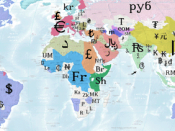Identify the main factors that led to the collapse of the Thai baht in 1997.
An export fed growth spurt spurred on huge investments in property. This in turn increased property values. An already stressed stock market was further weakened by the collapse of Thailand's major bank (Finance One). This coupled with the unsustainable peg on the baht to the dollar contributed to the collapse.
Do you think the sudden collapse of the Thai baht can be explained by the purchasing power parity theorem?
The PPP theory suggests that the purchasing power of two companies should be equal. The peg of the baht to the dollar clearly created an unfavorable shift. When the exports shifted to imports to sustain the massive construction efforts, the baht could not maintain its position.
What role did the speculators play in the fall of the Thai baht? Did they cause it's fall?
The speculators forced the Thai government to invest its money in forward contracts.
This made the peg against the dollar weak, and the government was unable to defend it. Although a major player, the speculators did not force the compromised position of the economy.
What steps might the Thai government have taken to preempt the financial crisis that swept the nation in 1997?
The Thai government should have exercised some control over the export to import shift. The major influx of imports was one of the key factors in the weakening of the baht.
How will the collapse of the Thai baht affect businesses in Thailand, particularly those that purchase inputs from abroad or export finished products?
The Thai based businesses will have a tougher time purchasing imports with their weakened baht. This will make Thai products very enticing for interests abroad. The compromised position of the baht almost insures that...



This is a college essay?!?!
This is nothing more than a series of questions and answers, and certainly nothing like an essay. Typing out your homework after answering the questions at the end of the chapter is hardly a justifiable basis for submitting it to cheathouse and expecting points or thanks for your efforts.
2 out of 7 people found this comment useful.